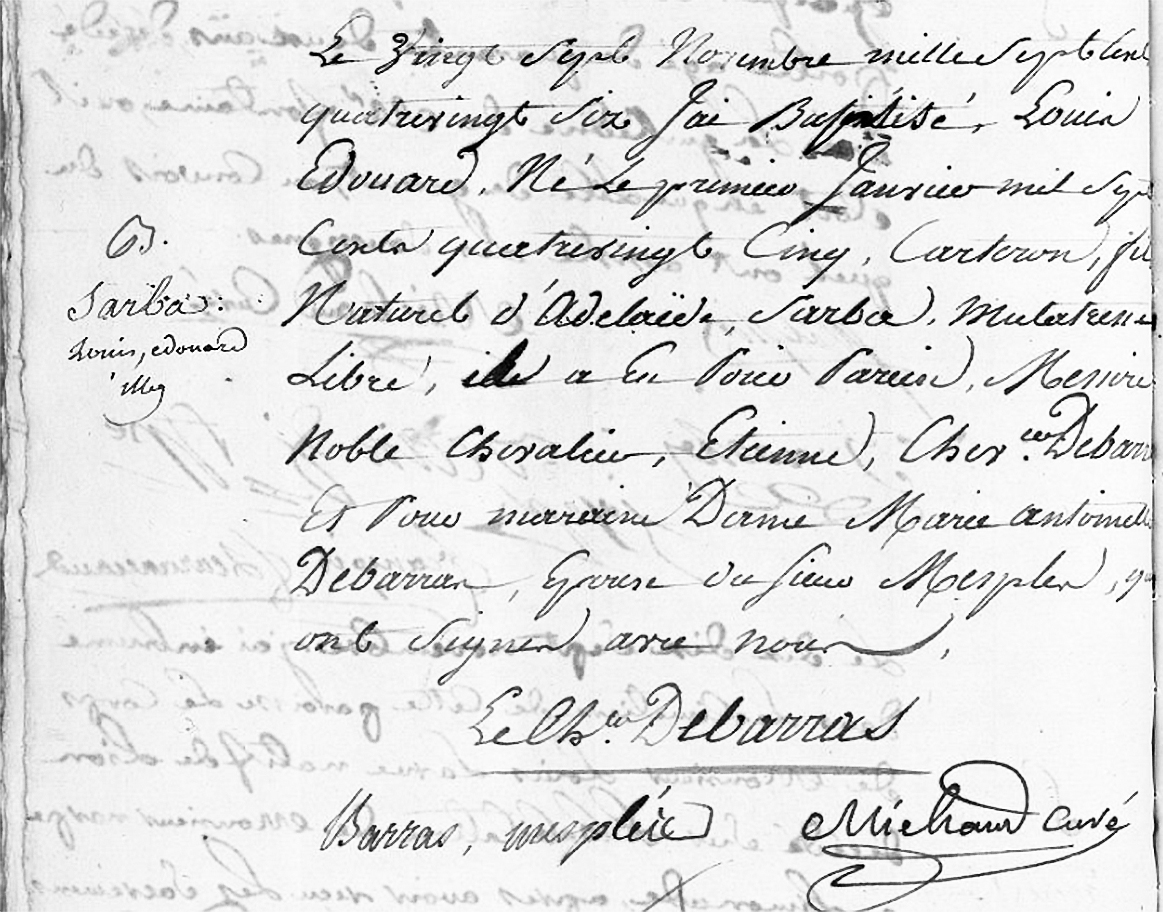Étienne de Barras
Géricault Life
1821 Le général Toussaint Louverture reçevant un général anglais (lithograph, detail) *, François Grenier de Saint Martin. Image courtesy of Musée du Quai Branly, Paris.
Étienne de Barras
I introduced the Chevalier Étienne de Barras in our article on Adélaide Sarba, Claude de Barras, and their children in our April issue. Étienne de Barras died in Paris on January 19, 1816, at n° 22, rue Louis le Grande. Standard accounts report that Étienne de Barras arrived in the city from Saint Domingue by way of New York sometime after 1798. Of all Théodore Géricault’s distant Saint Domingue relations, Étienne de Barras is perhaps the most complex and compelling.
Like several of his brothers and sisters also born in Saint Pierre, Martinique, Étienne de Barras was born in this small island colony in 1752. His parents Jean-Jacques-Antoine de Barras and Anne-Rose de Paul were born in Marseilles, where André their first son was born in 1741. The couple moved to Martinique sometime after, and then to Saint Domingue. During their marriage Jean-Jacques and Anne-Rose had at least three sons and five daughters.
In April of 1779, Étienne’s older brother André, by then an accomplished naval officer, died fighting for France’s colonial interests on the coast of west Africa, (see the January issue). Étienne was at this time a plantation owner in Saint Domingue and an officer in the colonial militia. Using his family’s connections, Étienne obtained a place in the French navy as an auxiliary officer in 1780. In 1781, Étienne served in Chesapeake Bay, where he commanded a sloop. After distinguishing himself in several actions, Étienne sought a position as a port captain, or harbor master, in Saint Domingue.
Family connections, again, helped. Étienne obtained the position of port captain of Mole Saint Nicolas on the north-western extremity of Saint Domingue. We find the Chevalier Étienne de Barras baptising his brother Claude’s child Louis-Edouard Sarba in 1786, (see below). Events in Saint Domingue soon took a turn for the worse, however. Rebellion broke out in north-eastern Saint Domingue in the fall of 1790. By August, 1791, the plantations east and south of Le Cap were in flames. The violence persisted and conditions in the colony deteriorated.
In 1793, Britain invaded Saint Domingue. Étienne de Barras left his role as port captain and took up arms against the new French Republic, commanding a company of soldiers in Jeremie, in the south-west, where he and his brother Claude owned at least one plantation. Étienne then joined the legion of Montalembert as a major. Montalembert’s troops fought against the armies of Toussaint L’Ouverture and other rebel generals as part of Britain’s effort to control the colony until the British effectively admitted defeat in 1798.
I will add more detail to our account of Étienne de Barras shortly. We note only that when Étienne de Barras did arrive back in Paris, he took up residence with Pierre Audouin, the engraver, and Anne Laurent, the son-in-law and daughter of Pierre Laurent. As we have discussed on numerous occasions, the Laurent-de Barras-Robillard family’s active participation in the Paris art community likely played a significant role in Théodore Géricault’s decision to pursue his own career as an artist. Étienne de Barras was part of this same circle from 1809, at the latest, until his death in 1816.
His service against the French republic could hardly have been a secret. Indeed, his actions before 1793 and after helped win Étienne de Barras a place among the order of Saint Louis in 1814, and the rank of frigate captain in 1815, honors unlikely to escape the notice of fellow family members.
Baptism of Louis-Edouard Sarba

Baptême Sarba: Louis, Edouard illeg, 27-11-1786, Saint Domingue, LIMONADE, p. 7. ANOM, état civil, Image courtesy of the Archives Nationales (France).